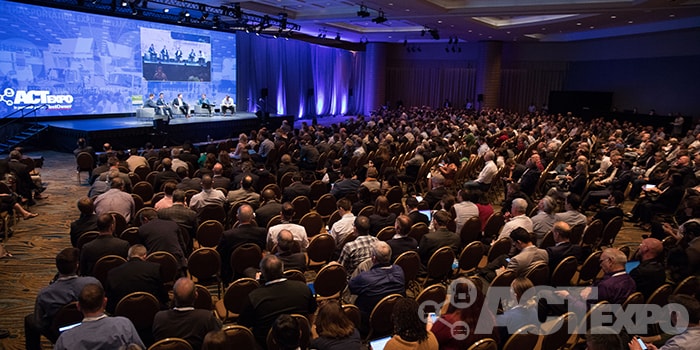Meeting the Needs of Hydrogen Vehicles and Zero-Emissions Technology at ACT Expo

Meeting the Needs of Hydrogen Vehicles and Zero-Emissions Technology at ACT Expo
Emissions reduction and efficiency are driving forces for automotive OEMs, and new clean transportation trends and technology were on full display at this year’s Advanced Clean Transportation (ACT) Expo in California.
The transportation industry is evolving, and ACT Expo has shifted accordingly in the past several years. Today, much of the show is sharply focused on zero- and low-emissions vehicles—technologies that many see as the future of transportation.
This is happening for a few reasons. New players are coming into the transportation and mobility space, disrupting typical models of both technology and business operations. New incentives are also in place in markets across the globe to spur new development in clean transportation technology and curb emissions. Because of this, it is being taken more seriously than ever before.
One thing was clear while I was at the show: As technology evolves, new challenges are arising for OEMs looking to succeed. Here are a few key observations I made while attending ACT Expo 2019:
Power, Range, and Infrastructure Challenges
Several factors will influence the increased adoption of clean technology vehicles and equipment, and suppliers are working to deliver solutions.
A spotlight is on electric vehicles (EVs). Today’s pure EVs are clean, and as battery costs continue to decline, these vehicles are becoming cost-effective solutions for short-distance commuting. They do have some inherent challenges, however. For instance, in heavy-duty and commercial trucking, fleet operators must be able to rely on extensive battery range to transport loads across long distances. Charging time is also an issue, charging times ranging from 30 minutes to 10 hours. These vehicles must also be able to rely on charging station infrastructure—much of which does not yet exist outside of some specific geographical areas. Finally, the raw materials required for manufacturing electric vehicle batteries are somewhat scarce, particularly in the United States. As they grow scarcer, costs may rise, and there will be another significant waste management challenge to overcome when many of these batteries reach the end of their lives.
This makes an alternative technology increasingly attractive: hydrogen fuel cell vehicles. These vehicles utilize hydrogen gas and oxygen to power an electric motor and can deliver a range of practical benefits, including zero emissions, major horsepower, and the torque required for heavy-duty applications. When generated using clean, renewable power, these vehicles can achieve true zero emissions. There are fewer drawbacks, too. Hydrogen fuel cell vehicle OEMs have demonstrated promising ranges that match traditional technologies (more than 300 miles), along with the potential for faster refueling time at hydrogen refueling stations.
Although there is also an infrastructure limitation for hydrogen transportation currently, some OEMs are making a considerable investment in changing that. Nikola Corporation, a company specializing in electric semitrucks and hydrogen fuel cell vehicles and a main-stage presenter at ACT Expo, has pledged to construct 700 hydrogen refueling stations across the United States by 2028. By tackling both the vehicle production and infrastructure problems at once, the company’s unique business model could make these vehicles more attractive to end-users.
Creating Efficient Infrastructure for Hydrogen Vehicles
Creating reliable infrastructure for hydrogen vehicles is key to making them a viable technology in the commercial and consumer space. Safe, efficient hydrogen storage in vehicles and at hydrogen refueling stations is an important part of that equation.
For practical on-road applications, a few things must be considered. Hydrogen has the highest energy per mass of any fuel but has a low energy-per-unit volume, requiring advanced storage methods that can deliver on the potential for higher energy density. Hydrogen in its liquid form requires cryogenic temperatures for storage, making it currently less attractive for vehicles. In its gaseous form, then, hydrogen storage efficiency requires high-pressure tanks and fuel systems typically ranging from 350 to 700 bar in vehicle applications, corresponding with a typical passenger car to a commercial truck.
Hydrogen storage efficiency and containment must be accomplished throughout an entire supply chain. Hydrogen is either generated on-site or delivered via tube trailers to hydrogen refueling stations, where it is then compressed for stationary storage in on-site tanks. From those tanks, the gas is transferred to the end-user-operated dispenser—the hydrogen version of a typical gas pump—where it eventually fills the hydrogen fuel cell vehicle. Importantly, pressures at refueling stations must be even higher—between 900 and 1,000 bar—to effectively meet the pressure needs in the vehicles themselves.
Maintaining acceptable high pressures and preventing costly leaks at any point throughout the hydrogen transportation infrastructure are critical to making the technology viable, efficient and practical for a variety of transportation applications. Design and material selection for this new kind of hydrogen fuel architecture must take these high pressures and leak-tight performance into account.
These are just some of the clean transportation trends in the industry that are worth following. Contributing to a more sustainable future is important, and we at Swagelok are committed to providing our support, assistance and quality products for OEMs working to develop viable, zero- or low-emissions vehicle technology in the coming years and decades. We have extensive experience in material science, extreme pressures and temperatures, and delivering reliable leak-tight connections in critical applications. We’re committed to applying that expertise to clean transportation needs. Meeting customer expectations around safety, efficiency, and reliability depends on it.

